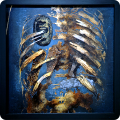Hiya CherryFlow, there's an informative video called "the Science of Sleep Paralysis" that explains a little about why it's usually a fearful experience. Here's the video. |
|
Results 1 to 3 of 3
Thread: Sleep Paralysis and Fear
-
09-07-2011 07:24 PM #1
 Sleep Paralysis and Fear
Sleep Paralysis and Fear
Hi ! : )
One of the main reasons I joined 'dream views' was to try to find a way to control my sleep paralysis fear. This is not the fear of having sleep paralysis..but rather the fear I feel while experiencing sleep paralysis. I'm also very confused about if what I am experiencing is sleep paralysis or just an LD? I know I am asleep, I know I am not fully conscious, and yet if I try to wake myself up I feel myself sinking deeper and deeper into my bed. Many times I'll feel the presense of something evil or someone trying to hurt me standing over me, and yet no matter how hard I try to open my eyes I can not. Sometimes I imagine myself opening my eyes and turning my lights on...but I know that when I imagine this I am not really doing it and that I am still asleep. I usually feel some kind of anxiety at this point...causing me to try even harder to wake up thus feeling even more frustrated.
I'm wondering if anyone else has similiar problems or if there is a way to get yourself out of sleep paralysis faster and back into the conscious world?
Thanks for any help !
-
09-07-2011 07:39 PM #2Bird Brain Achievements:









- Join Date
- Oct 2009
- LD Count
- Lost count.
- Location
- Vancouver, BC.
- Posts
- 6,337
- Likes
- 2066
- DJ Entries
- 212
We all live in a kind of continuous dream. When we wake, it is because something,
some event, some pinprick even, disturbs the edges of what we have taken as reality.
Vandermeer
SAT (Sporadic Awareness Technique) Guide
Have questions about lucid dreaming? DM me.
-
09-09-2011 11:07 PM #3DreamDragon Achievements:








- Join Date
- Jun 2011
- LD Count
- 190 (31.11.23)
- Gender

- Location
- Tibaro
- Posts
- 1,154
- Likes
- 668
- DJ Entries
- 114
Just like told in the video, don't take it as something negative, take it as a chance. I'm not "gifted" with easily achieving states of sleep paralysis and I tried to achieve such states quite often for quie a while now. I myself can only envy people who naturally encounter states of SP.
Puffin pretty much said everything important, the more you understand what's happening and the less you see it as negative, the less negative it is.Personal Records so far: Max lucids per day: 2 | Max lucids per week: 4 | Max lucids per month: 8 | Max dreams recalled in one night: 17
Longest lucid dream: ~35min | Highest flight: zoomed out of common existence [WTF?] | Fastest speed: FTL | DILD/EILD/DEILD [X] | WILD/VILD [X] | MILD/FILD/HILD [ ]
Interested to know how I got 17 dreams in one single night? And how I think I still could Improve? Check out my new and improved Dream Recall Compendium: The Dream Recall Compendium
Similar Threads
-
Getting over my fear of Sleep paralysis
By Ganjaaah in forum Attaining LucidityReplies: 2Last Post: 09-09-2010, 03:48 AM -
Almost to Sleep Paralysis but fear got me
By Dragon Wolf in forum Introduction ZoneReplies: 3Last Post: 12-22-2009, 08:23 PM -
Sleep Paralysis is Nothing to Fear
By Artixknight in forum General Lucid DiscussionReplies: 14Last Post: 10-02-2009, 06:14 AM -
Fear Sleep Paralysis
By fragmastr in forum Attaining LucidityReplies: 7Last Post: 05-05-2009, 04:25 AM -
how to get over the fear of sleep paralysis?
By Stardrowned in forum Attaining LucidityReplies: 3Last Post: 02-04-2009, 10:05 PM




 1Likes
1Likes LinkBack URL
LinkBack URL About LinkBacks
About LinkBacks





 Reply With Quote
Reply With Quote If you experience sleep paralysis enough, you'll get used to the sensations and won't be afraid (or as afraid) anymore. After all, you know exactly what to expect and what kind of hallucinations could occur. And, you know that it's completely safe. Nothing can hurt you; if for some reason you feel suffocated or pain, that too isn't real.
If you experience sleep paralysis enough, you'll get used to the sensations and won't be afraid (or as afraid) anymore. After all, you know exactly what to expect and what kind of hallucinations could occur. And, you know that it's completely safe. Nothing can hurt you; if for some reason you feel suffocated or pain, that too isn't real.
Bookmarks